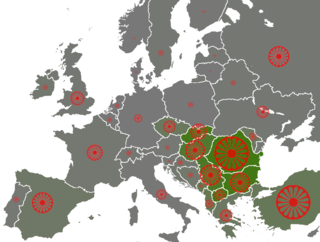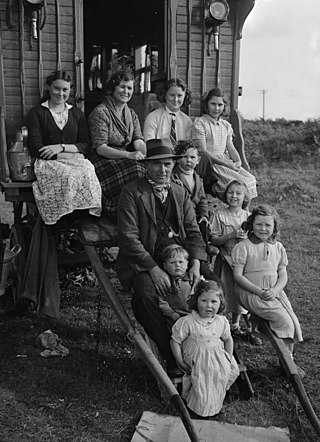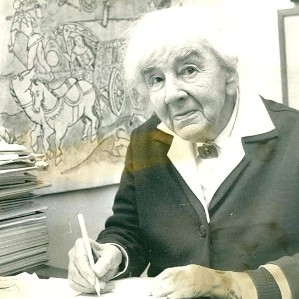
The Romani, also spelled Romany or Rromani, colloquially known as the Roma, are an Indo-Aryan ethnic group who traditionally lived a nomadic, itinerant lifestyle. Linguistic and genetic evidence suggests that the Romani originated in the Indian subcontinent; in particular, the region of present-day Rajasthan. Their subsequent westward migration, possibly in waves, is now believed by historians to have occurred around 1000 CE. Their original name is from the Sanskrit word डोम (doma) and means a member of a Dalit caste of travelling musicians and dancers. The Roma population moved west into the Persian Ghaznavid Empire and later into the Byzantine Empire. The Roma arrived in Europe around the 13th to 14th century. Although they are dispersed, their most concentrated populations are located in Europe, especially central, eastern, and southern Europe, as well as western Asia.

The Lom people, also known by non-Loms as Bosha or Posha or as Armenian Romani or Caucasian Romani, are an ethnic group originating from the Indian subcontinent. Their Lomavren language is a mixed language, combining an Indo-Aryan substrate with Armenian.

The Romani people are a distinct ethnic and cultural group of peoples living all across the globe, who share a family of languages and sometimes a traditional nomadic mode of life. Though their exact origins are unclear, central India is a notable point of origin. Their language shares a common origin with, and is similar to, modern-day Gujarati and Rajasthani, borrowing loan words from other languages as they migrated from India. In Europe, even though their culture has been victimized by other cultures, they have still found a way to maintain their heritage and society. Indian elements in Romani culture are almost non-existent, with the exception of their language. Romani culture focuses heavily on family. The Roma traditionally live according to relatively strict moral codes.

The Romani flag or the flag of the Roma is the international ethnic flag of the Romani people, historically known as "Gypsies", which form a stateless minority in countries across Eurasia, Africa, the Americas, and Australasia. It was approved by the representatives of various Romani communities at the first and second World Romani Congresses (WRC), in 1971 and 1978. The flag consists of a background of blue and green, representing the heavens and earth, respectively; it also contains a 16-spoke red dharmachakra, or cartwheel, in the center. The latter element stands for the itinerant tradition of the Romani people and is also an homage to the flag of India, added to the flag by scholar Weer Rajendra Rishi. It superseded a number of tribal emblems and banners, several of which evoked claims of Romani descent from the Ancient Egyptians.

Romani people in Bulgaria constitute Europe's densest gypsy minority. The Romani people in Bulgaria may speak Bulgarian, Turkish or Romani, depending on the region.
Romani folklore encompasses the folktales, myths, oral traditions, and legends of the Romani people. The Romani were nomadic when they departed India during the Middle Ages. They migrated widely, particularly to Europe, while other groups stayed and became sedentary. Some legends say that certain Romani have passive psychic powers such as empathy, precognition, retrocognition, or psychometry. Other legends include the ability to levitate, travel through astral projection by way of meditation, invoke curses or blessings, conjure or channel spirits, and skill with illusion-casting. The belief in vampires originated from the Roma. The Roma from Slavic countries believe in werewolves.

The Crimean Roma are a sub-ethnic group of the Muslim Roma heavily assimilated among Crimean Tatars to the point that they are often considered to be the fourth subgroup of Crimean Tatars. Currently, they live in many countries of the former Soviet Union, including Russia. They speak the Crimean Tatar language and their own Crimean Romani dialect. Crimean Roma traditionally practice Islam.

The Romani people have several distinct populations, the largest being the Roma and the Calé, who reached Anatolia and the Balkans in the early 12th century, from a migration out of the Indian subcontinent beginning about 1st century – 2nd century AD. They settled in the areas of present-day Turkey, Greece, Serbia, Romania, Croatia, Moldova, Bulgaria, North Macedonia, Hungary, Albania, Kosovo, Bosnia and Herzegovina, Czech Republic, Slovenia and Slovakia, by order of volume, and Spain. From the Balkans, they migrated throughout Europe and, in the nineteenth and later centuries, to the Americas. The Roma population in the United States is estimated at more than one million.
Scottish Travellers, or the people in Scotland loosely termed Romani persons or travellers, consist of a number of diverse, unrelated communities that speak a variety of different languages and dialects that pertain to distinct customs, histories, and traditions.
Romani studies is an interdisciplinary ethnic studies field concerned with the culture, history and political experiences of the Romani people. The discipline also focuses on the interactions between other peoples and Romas, and their mindset towards the Romas.

Muslim Romani people are people who are ethnically Roma and profess Islam. There are many different Roma groups and subgroups that predominantly practice Islam, as well as individual Romani people from other subethnic groups who have accepted Islam. Xoraxane Roma in Balkan Romani language, are non-Vlax Romani people, who adopted Sunni Islam of the Hanafi madhhab at the time of the Ottoman Empire. Some of them are Derviş of Sufism belief, and the biggest Tariqa of Jerrahi is located at the largest Arlije and Gurbeti Muslim Roma settlement in Europe in Šuto Orizari, locally called Shutka in North Macedonia have their own Romani Imam and the Muslim Roma in Šuto Orizari use the Quran in Balkan Romani language. Many Romanlar in Turkey, are members of the Hindiler Tekkesi a Qadiriyya-Tariqa, founded in 1738 by the Indian Muslim Sheykh Seyfullah Efendi El Hindi in Selamsız. Roma Muslims in Turkey and Balkan are mostly cultural Muslims or nominal Muslims.

The Kale are a group of Romani people in Wales. Many claim to be descendants of Abram Wood, who was the first Rom to reside permanently and exclusively in Wales in the early 18th century, although Romanichal Travellers have appeared in Wales since the 16th century. Welsh Kale are almost exclusively found in Northwest Wales, specifically the Welsh-speaking areas. Romanichal Travellers inhabit South Wales and North East Wales.

John Sampson (1862–1931) was an Irish linguist, literary scholar and librarian. As a scholar he is best known for The Dialect of the Gypsies of Wales (1926), an authoritative grammar of the Welsh Romani language.

The Romani people are also known by a variety of other names; in English as gypsies or gipsies, and Roma; in Greek as γύφτοι (gíftoi) or τσιγγάνοι (tsiggánoi), in Central and Eastern Europe as Tsingani ; in France as gitans besides the dated terms bohémiens and manouches; in Italy as rom and sinti besides the dated terms zingari, sigani, and gitani; in Spain as gitanos; and in Portugal as ciganos.
The Zargari people are a Muslim Romani people ethnic group deriving from Zargar, Iran and inhabiting Northwestern Iran. They speak the Zargari Romani a distinct dialect of the Balkan Romani, most closely related to those of Rumelia. Historical documentation of their origins is lacking, but one seemingly-accurate tradition traces their origins to three Kuyumcu (Goldsmith) brothers,, who were migrated from Ottoman-held Rumelia, Maritsa Valley, today South Bulgaria to Ottoman Damascus from there invited to Shiraz as hostages during the reign of Nader Shah (1736-1747), and given pasture lands as a reward for their skills. As Romani, they were also exempted from taxation and military service.

The International Romani Union, formerly known as the International Gypsy Committee and International Rom Committee, is an organization active for the rights of the Romani people. Its seat is in Vienna. The International Romani Union also has offices in Skopje, North Macedonia, and Washington, D.C., USA.
Elena Marushiakova is a historian and ethnographer working in field of Romani Studies, of Slovak and Russian origin, who has lived and studied in Slovakia and Bulgaria. In 2016 she became a Research Professor in the School of History at the University of St Andrews. Elena Marushiakova became the president of the Gypsy Lore Society.

Dora Esther Yates was a British bibliographer, linguist and Romani scholar. She understood every dialect of Romani and she became the de facto secretary of the Gypsy Lore Society in 1922.
Leeds University Library's Gypsy, Traveller and Roma Collections are one of the five Designated collections held by the Brotherton Library at the University of Leeds. They comprise an extensive range of international books, manuscripts and archives relating to Gypsy, Traveller and Roma culture. Most of the collections are not about or by the communities but relate to the way they have been represented in the past.
Romani Studies is a biannual peer-reviewed academic journal covering all aspects of Romani/Gypsy studies. It is the official journal of the Gypsy Lore Society. It was established in 1888 and until 1982 was published as the Journal of the Gypsy Lore Society. Its publication resumed in 1991 and in 2000 the journal obtained its current title. The society currently publishes it in association with the Liverpool University Press.











